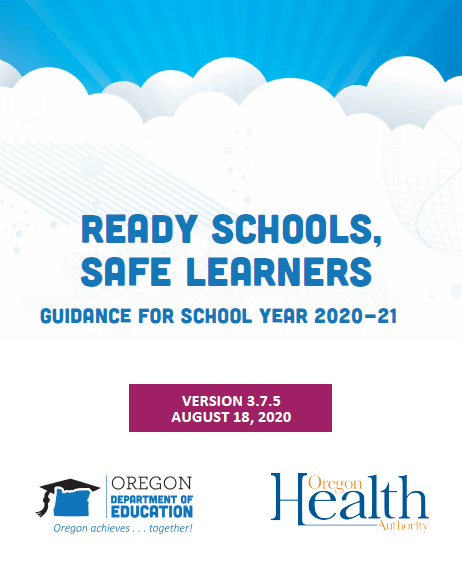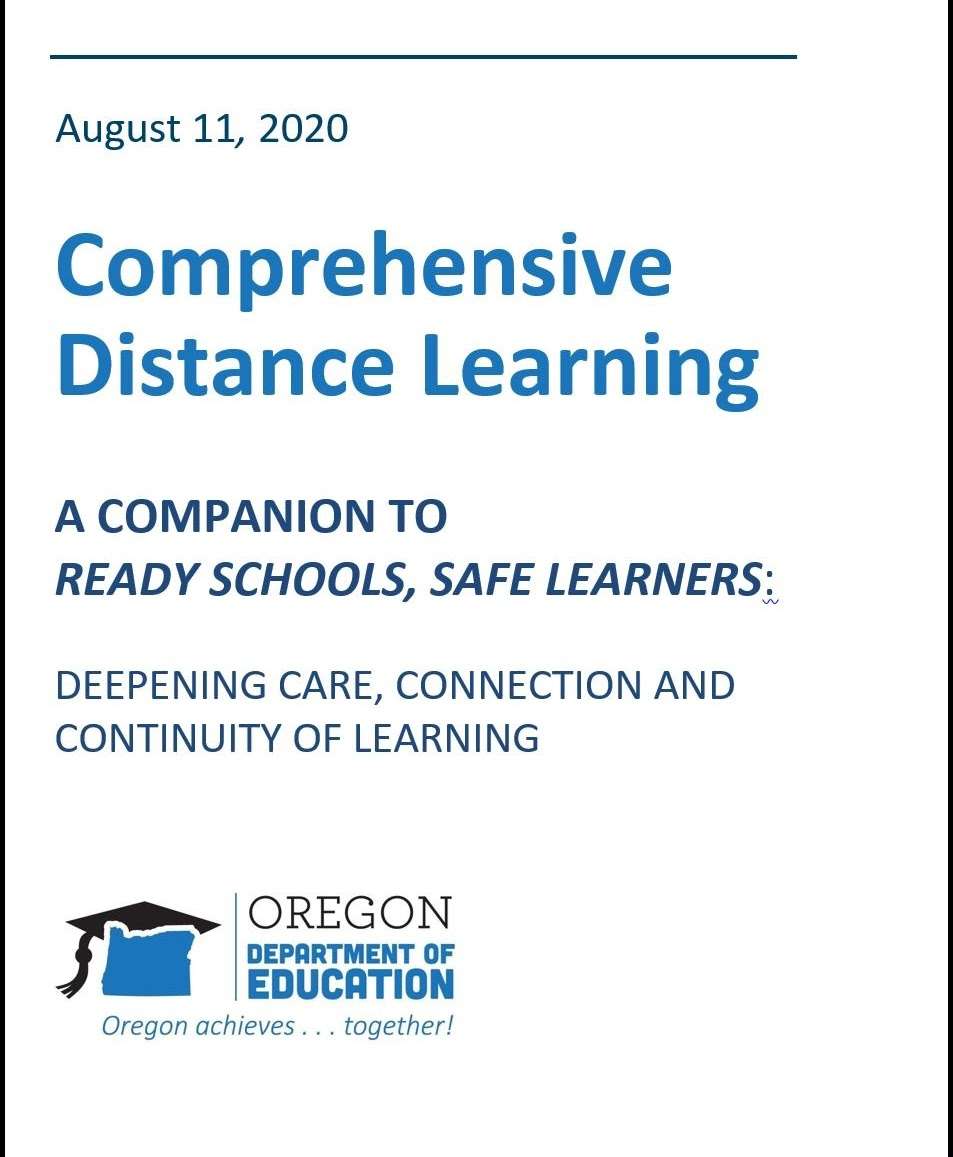2020-21 School Year Plan

August 11, 2020
Dear Students, Parents, and Community Members:
On Monday, July 27, Governor Brown unveiled a new metric for the reopening of Oregon public schools. The new metric was designed to help ensure that Oregon students returning to school would be as safe as possible in these unprecedented times. During times like these, I am grateful to be living on the Oregon Coast, where we have plenty of open spaces with an abundance of outdoor recreational opportunities.
Based on Governor Brown’s directive, Bandon School District will be opened under a Comprehensive Distance Learning model for the first 9-week quarter of the 2020-2021 school year. This means that when school begins in September, Bandon students will not meet in-person, but will instead attend classes off campus via distance learning.
At this time, we are changing the start date of the schools’ Comprehensive Distance Learning to September 14th for students in grades 6-12. We are planning on September 21st as a soft start date for grades K-5 to allow teachers to meet with parents individually and set families up for success with distance learning.
With Comprehensive Distance Learning, students will be held accountable to a level of academic performance and course rigor that was our expectation within your classrooms prior to the school closure in March. Our transition to CDL is one of high expectations for both students and staff. Through CDL, students are guaranteed access to standards- based, grade level OR beyond educational content.
Much like we did last spring, Bandon School District will work hard to get technology to families and create more engaging distance learning lessons for our students. We will also continue feeding our school families and make sure we are supporting them in ways beyond just the classroom setting.
I am keenly aware that this is not the announcement many of you were hoping to hear from us. Please believe me when I say that this is not the plan we wanted to send out. We want our students back in school! We just want to make sure that when they arrive, we are doing so safely within the pandemic’s challenges.
Over the next few days, we will be sending out more information, which will include updates on athletics, registration, school calendar, technology check out process, signing up for meals, etc. Please continue to check the district website and Facebook for these updates.
Sincerely,
Doug Ardiana Superintendent

Below you will find the links to the framework for schools for the 2020-21 school year that ensures the health and safety of all students and staff and the families they return to each day.
Click on the images below to review the documents.


A Guide for At-Home Learning from ODE
The coronavirus (COVID-19) pandemic has changed the way we work, learn, and connect. This global event presents unique challenges for all families and educators as we adjust to new norms and come to understand what this means for elementary and secondary learners. The Oregon Department of Education (ODE) is committed to supporting families and caregivers during these difficult times of social distancing and school closures. While school districts in Oregon will vary in how they provide assigned work and resources for at-home learning, caregivers can support their children in a variety of ways. While it is important to acknowledge that at-home learning does entail changing some family routines, this document intends to provide some recommendations to help with this transition.
Key points to remember:
Student, family, and community physical and emotional well-being come first. Learning only happens when children and young people feel happy, safe, and secure. Be patient with yourself and your family–this is new for everyone. Provide your children with reassurance and love. As schools close, and the news cycle is dominated by information about COVID-19, children will be frightened and confused. Take care of your child’s emotional and health needs during this time. If any of your family is sick, that is the number one priority, not at-home learning.
Communicate openly and honestly about COVID-19. Acknowledge and discuss changes and challenges that may have occurred in your family and routines. Caregivers should stay positive and reassure children that health and school officials are working hard to make sure everyone stays safe and healthy. However, children also need factual, age-appropriate information about disease risk and concrete instruction about how to prevent spread of the disease. For more information, see CDC’s Guide for Talking to Children.
Do not neglect your own needs. Make sure to attend to your physical and mental health needs, including maintaining a healthy diet, staying physically active, and connecting with others about your feelings. Reach out to available community networks and resources. Read about ways to support your family with their stress and trauma here.
No need to recreate school. Trying to create school-like learning in a home setting may frustrate teachers, students, and families. Continue doing what you already do: be a learning partner to your child. You don’t need to be an expert in any subject area or in any learning strategy! Engage with your child to share and connect learning to your home lives, interests, home language, and cultural identities — these moments are just as important. Parents are not expected to become teachers, though they will likely be needed to serve as facilitators of learning, particularly for younger students.
Use technology intentionally. It is important for friends, family, teachers, school staff, and other community members to stay in virtual contact with each other — but consider variety, including exercise, reading, and learning life skills away from screens. For a list of digital resources, visit Oregon Open Learning on OER Commons.
Connect with your community and school. Every school and district will have different capacity to support at-home learning and provide assigned work. However, caregivers and family should always check for support, resources, and guidance from community groups and your school district. You are not in this alone.
Some recommendations:
- Spark simple conversation. Support your child’s thinking with questions. Open-ended questions will stimulate more conversation than questions that can be answered with a yes or no. Whenever possible, refrain from judging your child’s thinking by asking them to clarify or justify. And remember, even boredom has value — it can spark creativity and problem-solving.
- Read an article or view a documentary together and ask questions like “what do you notice?” or “what do you wonder?”
- Use books, images, or online resources to spark deeper conversations.
- Ask about and share feelings with family members about recent changes in routine.
- Maintain some routine. Consider maintaining a routine because the consistency of a schedule reduces anxiety and stress. Talk with your children about their learning and goals — and remember to take regular breaks.
- What is a realistic time commitment for at-home learning in your family?
- breakfast at the same time each day.
- Identify a time and place for assigned school work.
- Get creative about meeting physical activity needs of all family members.
- Focus on learning in everyday life. Many activities you already do around the home support meaningful learning, including paid and unpaid work. Try using a typical activity, such as preparing food or cleaning up, to encourage new learning or to develop a new skill. Similarly, there may be ways to engage your child as part of your own paid work.
- Share your work process by thinking out loud.
- Involve your child in a small part of a bigger daily activity (e.g. laundry, cooking, cleaning).
- Help your child plan a day or a meal or a family walk.
- Ask your child to create a video or written “how to” manual to share what they learned.
- Build from the interests and choices of your children. We know children are more engaged when they have choice in deciding what they learn and when the content is relevant to their lives. You know your child — ask about interests that they do not always get to pursue in school. Are there projects, ideas, or collaborations that might connect their interests to learning?
- Create an art project with recycled materials, using your child’s interests as a theme.
- Re-imagine your outdoor and/or indoor spaces as an adventurer to spark imagination.
- Keep an individual and/or family journal to record ideas, events, feelings.
- Invent a game to play with your family or online friends.
- Help children find purpose in their learning. As the connections previously sustained through daily in-person interactions weaken, it is more important than ever for young people to strengthen community bonds and build new community bonds. Doing so will help children feel a sense of solidarity with others and foster hope and agency.
- Work with your child to write cards for healthcare workers and others on the front lines.
- Ask your child to tutor younger siblings or other students transitioning to online learning.
- Help your child check in with their friends over FaceTime/Houseparty/Zoom calls.
- Create ideas to spread kindness, whether that’s playing music for your neighbor or checking in with elderly neighbors.

